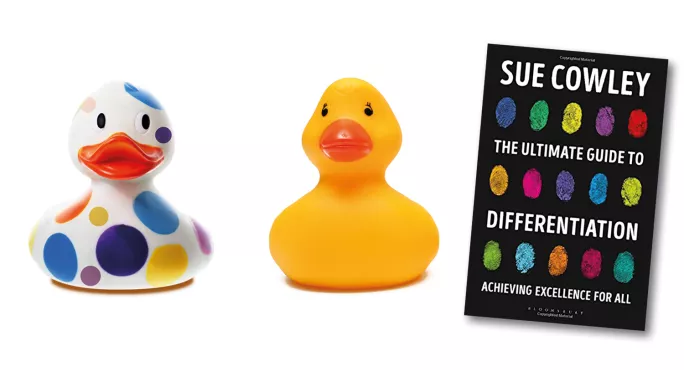- Home
- Book review: The Ultimate Guide to Differentiation
Book review: The Ultimate Guide to Differentiation

Sue Cowley, best known for Getting the Buggers to Behave, but also known for many other practical guides to teaching, has done it again with The Ultimate Guide to Differentiation.
Readers might be familiar with Cowley’s The Seven T’s of Practical Differentiation, a shorter book focused on providing tips that can be taken straight into the classroom.
Those hoping for more of the same won’t be disappointed. There are more than 90 practical suggestions, some, but not all, of which are found in the earlier book. Yet this “Ultimate Guide” does much more than this: it prompts thought; it asks great questions; it offers ways to implement strategies, useful to the NQT and senior leader alike.
The introduction should be compulsory reading for anyone undertaking initial teacher training. It is refreshing for the subtlety of its approach. “We tend to think of differentiation,” Cowley says, “as preparing a variety of worksheets for different learners… but, in reality, it is the subtle, flexible and responsive approaches you use that are the nuts and bolts of everyday differentiation.”
Differentiation is not, she writes, only about differences of ability. Of course, that’s a relevant difference in the classroom, but so are all sorts of other differences. Students have different interests and backgrounds; they might have special educational needs and disability, and English might not be their first language. They might be really mature among their peers, or not so. They might be quick and careless, or slow and methodical. All of these, Cowley says, are relevant in differentiating well.
The choice of fingerprints for the front cover is apt. As Cowley sees it, differentiation can be truly effective only when we are responding to the complex needs of individuals, each of whom has their own special mix of interests, skills, background and motivations.
This means that good differentiation goes hand in hand with good relationships between teachers and students; something with which I wholeheartedly agree. Cowley recognises that this is easier said than done, though, especially in senior schools where you might only see a student once a week. Ever practical, Cowley is on hand to help, with a host of ways to get to know students better, even if you are “going in cold”.
Mixed messages
The book is split into five chapters: Planning; Resources; The Learners; The Teacher and the Teaching; and Assessment. Largely, these are helpful delineations, but there is inevitably some overlap - planning can’t be totally separated, conceptually, from the learners or the teaching.
In the chapter on the learners, I felt there were mixed messages. On the one hand, Cowley is careful to underline the importance of approaching students as individuals, with many and varied needs. Yet 12 of the 19 pages in the chapter focus on SEND and English as an additional language. Why is this? Aren’t students’ interests as potent in determining what and how they learn? Are those particularly in need of stretching not also in need of a couple of pages here? From everything else Cowley writes, it is clear that she thinks all of these are important. It is, therefore, not clear why, in this chapter, the focus on learners’ needs is skewed in this predictable direction.
There were moments, too, when I wished for a more research-led approach. In particular, the list of pros and cons of setting by ability was disappointing. There has been plenty of research in this area, and I really think that, given that she has said that differentiation is about so much more than ability, she could have been more probing.
Sometimes, I found myself wondering what the Ultimate Guide to Outstanding Teaching would contain that this book doesn’t. If one implemented Cowley’s strategies well, it is hard to see what would be missing from one’s teaching. Are these differentiation strategies, or are they just strategies for engaging and effective teaching and learning? Perhaps this is not a shortcoming. After all, great teaching is great differentiated teaching; differentiating should be core to what we do.
Overall, the approach is exactly what we have come to expect from Cowley. It is clear that what she writes comes from a depth of professional know-how and boots-on-the-ground experience.
As with the best of mentors, Cowley’s advice is practical, ambitious but never unrealistic. The deep respect that she has, both for teachers and for students, is palpable in every word. Those new to teaching and, indeed, those who are honing their practice, will be encouraged, and never alienated, along every step of the way.
Clare Jarmy is head of academic enrichment and Oxbridge, and head of religious studies and philosophy, at Bedales School in Hampshire
Keep reading for just £1 per month
You've reached your limit of free articles this month. Subscribe for £1 per month for three months and get:
- Unlimited access to all Tes magazine content
- Exclusive subscriber-only stories
- Award-winning email newsletters



